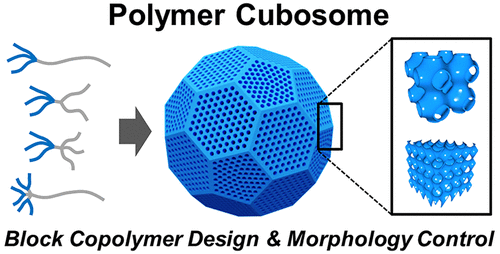当前位置:
X-MOL 学术
›
Acc. Chem. Res.
›
论文详情
Our official English website, www.x-mol.net, welcomes your feedback! (Note: you will need to create a separate account there.)
Polymer Cubosomes: Infinite Cubic Mazes and Possibilities.
Accounts of Chemical Research ( IF 18.3 ) Pub Date : 2020-01-10 , DOI: 10.1021/acs.accounts.9b00563 Sungmin Ha 1 , Yunju La 1 , Kyoung Taek Kim 1
Accounts of Chemical Research ( IF 18.3 ) Pub Date : 2020-01-10 , DOI: 10.1021/acs.accounts.9b00563 Sungmin Ha 1 , Yunju La 1 , Kyoung Taek Kim 1
Affiliation

|
Block copolymers (BCPs) have been indispensable building blocks to create a range of soft nanostructures including discrete particulates (micelles and vesicles) and periodic structures via spontaneous assembly in bulk and in solution. The size, shape, and phase of these structures can be controlled by the rational design of the molecular structure of building blocks based on the structural analogy of BCPs to lipids and small molecule surfactants. Inverse bicontinuous cubic mesophases of polymers, or polymer cubosomes when in colloidal forms, are emerging nanostructures composed of triply periodic minimal surfaces (TPMSs) of block copolymer bilayers. Created by spontaneous assembly of BCPs in solution, polymer cubosomes internalize two nonintersecting nanochannel networks arranged in a cubic crystalline order. As well-defined porous particles with highly ordered internal structures and high surface-area-to-volume ratios, polymer cubosomes can be used for chemical reactors or bioreactors, carriers capable of cargo loading and release, and scaffolds for nanotemplating. However, despite their structural similarity to lipid cubosomes and applicability, polymer cubosomes have been only sporadically observed as an outcome of serendipity until recent studies demonstrated that BCPs could form well-defined polymer cubosomes in solution.In this Account, we describe our recent progress in creating polymer cubic mesophases and their colloidal particles (polymer cubosomes) in dilute solution. BCPs with nonlinear architectures (dendritic-linear, branched-linear, and branched-branched BCPs) preferentially self-assembled to inverse mesophases in solution when the block ratio (f), defined as a molecular weight ratio of the hydrophilic block to that of the hydrophobic block, was small (<10%). The resulting lyotropic structures transformed from flat bilayers to cubic phases of primitive cubic and double diamond lattices and finally to inverted hexagonal phases as f decreased. We proposed that the architecture of a BCP plays an important role in the preferential formation of polymer cubosomes in solution. The presence of the bulky hydrophilic block limited chain stretching of the hydrophobic polymer block, which would increase the packing parameter of the BCP to greater than unity, a prerequisite for inverse mesophase formation. The structural characteristics of polymer cubosomes, such as lattice symmetries, pore sizes, and lattice parameters, could also be controlled by fine-tuning the structural parameters of BCPs. We also suggested nonsynthetic methods to precisely control the phase and internal lattice of inverse mesophases of BCPs by the coassembly of two BCPs with different block ratios (mix-and-match approach) and the modulation of the affinity of the common solvent toward the hydrophobic block of the BCP. To investigate the potential applications of polymer cubosomes, we prepared inorganic photonic crystals using a cubosome-templated synthesis. We also discussed the utilization of cubosomes as chemical reactors by functionalization of the surface and the covalent stabilization of transient self-assembled structures via cross-linking of the hydrophobic domain. This Account reflects the efforts of synthetic chemists to understand the self-assembly behavior of BCPs to form complex morphologies in solution. We hope that our Account inspires efforts from chemists and other scientists to further understand these structures with infinite mazes of complexity and possibility.
中文翻译:

聚合物立方体:无限的立方迷宫和可能性。
嵌段共聚物(BCP)是不可或缺的构建基块,可通过散装和溶液中的自发组装产生一系列柔软的纳米结构,包括离散的颗粒(胶束和囊泡)和周期性结构。这些结构的大小,形状和相可以根据BCP与脂质和小分子表面活性剂的结构相似性,通过合理设计构件分子结构来控制。当为胶体形式时,聚合物或聚合物立方体的反向双连续立方中间相是由嵌段共聚物双层的三重周期性最小表面(TPMS)组成的新兴纳米结构。通过溶液中BCP的自发组装,聚合物立方小体将两个不相交的纳米通道网络以立方晶格顺序内在化。作为具有良好内部结构和高表面积/体积比的良好定义的多孔颗粒,聚合物立方体可用于化学反应器或生物反应器,可装载和释放货物的载体以及用于纳米模板的支架。然而,尽管它们与脂质立方糖体在结构上具有相似性和适用性,但直到偶然的结果证明BCP可以在溶液中形成定义明确的聚合物立方糖体时,才偶然发现聚合物立方糖体是偶然的结果。在稀溶液中生成聚合物立方中间相及其胶体颗粒(聚合物立方体)。具有非线性架构(树突线性,分支线性,当嵌段比(f)定义为亲水性嵌段与疏水性嵌段的分子量之比较小(<10%)时,则在溶液中优先自组装为反相中间相。随着f的减小,所得的溶致结构从平面双层转变为原始立方晶格和双菱形晶格的立方相,最后转变为倒六角形相。我们提出,BCP的体系结构在溶液中聚合物立方微粒的优先形成中起着重要作用。庞大的亲水性嵌段的存在限制了疏水性聚合物嵌段的链拉伸,这将使BCP的堆积参数增加至大于1,这是中间相逆形成的前提。聚合物立方体的结构特征,例如晶格对称性,孔径和晶格参数也可以通过微调BCP的结构参数来控制。我们还建议采用非合成方法,通过将具有不同嵌段比率的两个BCP进行共组装(混合和匹配方法)并调节常见溶剂对疏水嵌段的亲和力,来精确控制BCP的反相中间相的相和内部晶格BCP。为了研究聚合物立方体的潜在应用,我们使用立方体为模板的合成方法制备了无机光子晶体。我们还讨论了通过表面官能化和通过疏水域的交联来稳定瞬时自组装结构的共价稳定性,将立方脂质体用作化学反应器。该说明反映了合成化学家为理解BCP的自组装行为以在溶液中形成复杂形态而做出的努力。我们希望我们的Account能够激发化学家和其他科学家的努力,以无限的复杂性和可能性迷惑进一步了解这些结构。
更新日期:2020-01-10
中文翻译:

聚合物立方体:无限的立方迷宫和可能性。
嵌段共聚物(BCP)是不可或缺的构建基块,可通过散装和溶液中的自发组装产生一系列柔软的纳米结构,包括离散的颗粒(胶束和囊泡)和周期性结构。这些结构的大小,形状和相可以根据BCP与脂质和小分子表面活性剂的结构相似性,通过合理设计构件分子结构来控制。当为胶体形式时,聚合物或聚合物立方体的反向双连续立方中间相是由嵌段共聚物双层的三重周期性最小表面(TPMS)组成的新兴纳米结构。通过溶液中BCP的自发组装,聚合物立方小体将两个不相交的纳米通道网络以立方晶格顺序内在化。作为具有良好内部结构和高表面积/体积比的良好定义的多孔颗粒,聚合物立方体可用于化学反应器或生物反应器,可装载和释放货物的载体以及用于纳米模板的支架。然而,尽管它们与脂质立方糖体在结构上具有相似性和适用性,但直到偶然的结果证明BCP可以在溶液中形成定义明确的聚合物立方糖体时,才偶然发现聚合物立方糖体是偶然的结果。在稀溶液中生成聚合物立方中间相及其胶体颗粒(聚合物立方体)。具有非线性架构(树突线性,分支线性,当嵌段比(f)定义为亲水性嵌段与疏水性嵌段的分子量之比较小(<10%)时,则在溶液中优先自组装为反相中间相。随着f的减小,所得的溶致结构从平面双层转变为原始立方晶格和双菱形晶格的立方相,最后转变为倒六角形相。我们提出,BCP的体系结构在溶液中聚合物立方微粒的优先形成中起着重要作用。庞大的亲水性嵌段的存在限制了疏水性聚合物嵌段的链拉伸,这将使BCP的堆积参数增加至大于1,这是中间相逆形成的前提。聚合物立方体的结构特征,例如晶格对称性,孔径和晶格参数也可以通过微调BCP的结构参数来控制。我们还建议采用非合成方法,通过将具有不同嵌段比率的两个BCP进行共组装(混合和匹配方法)并调节常见溶剂对疏水嵌段的亲和力,来精确控制BCP的反相中间相的相和内部晶格BCP。为了研究聚合物立方体的潜在应用,我们使用立方体为模板的合成方法制备了无机光子晶体。我们还讨论了通过表面官能化和通过疏水域的交联来稳定瞬时自组装结构的共价稳定性,将立方脂质体用作化学反应器。该说明反映了合成化学家为理解BCP的自组装行为以在溶液中形成复杂形态而做出的努力。我们希望我们的Account能够激发化学家和其他科学家的努力,以无限的复杂性和可能性迷惑进一步了解这些结构。



























 京公网安备 11010802027423号
京公网安备 11010802027423号